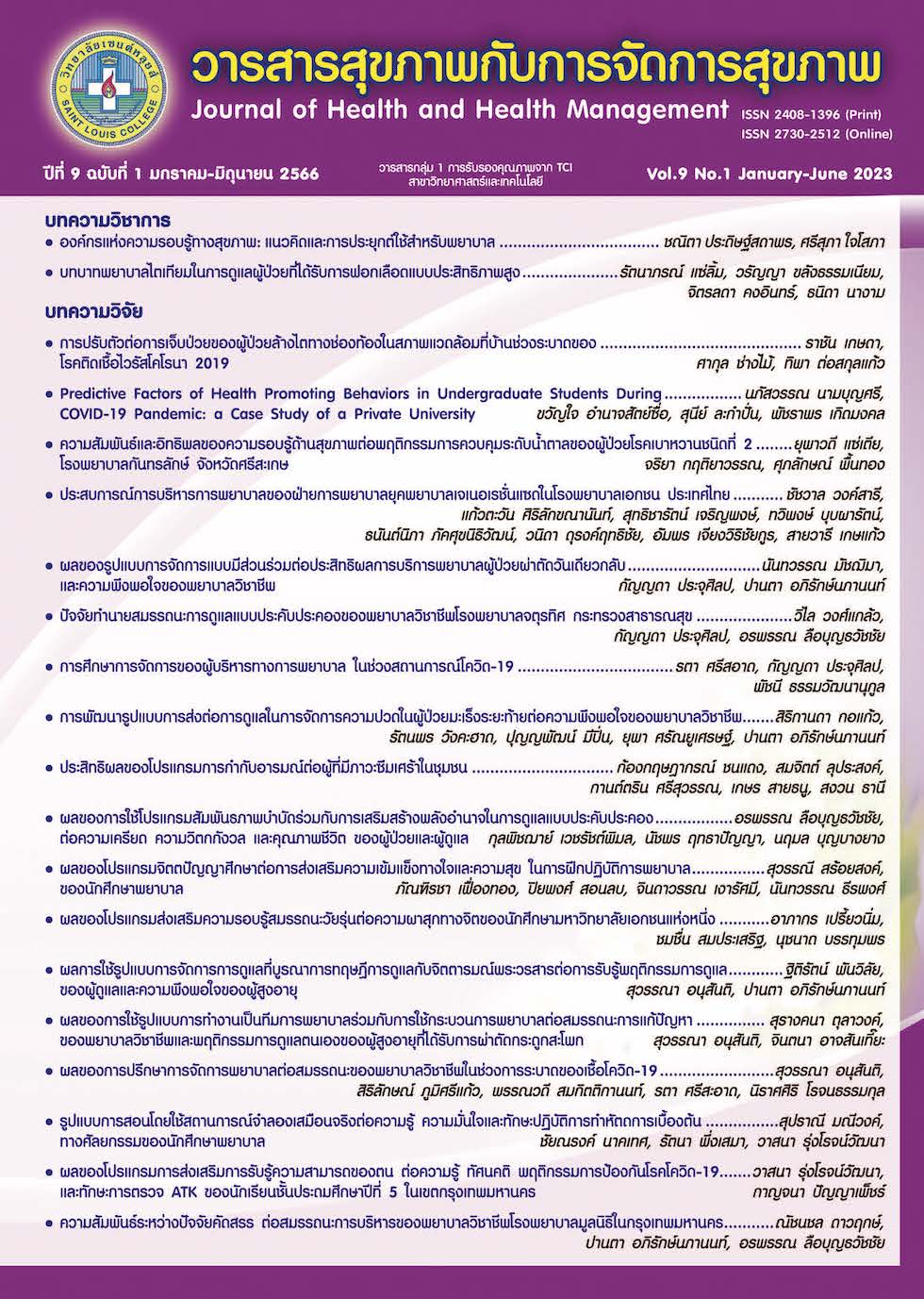Health Literacy Organization: Concept and Application for Nursing
Keywords:
Health Literate Organization, Organizational Health Literacy, NursingAbstract
Health literacy is the social cognitive learning process to encourage individuals’ ability or capacity to obtain, manage, and understand basic health information and services needed to make appropriate health decisions for themselves. Recognizing that addressing health literacy is critical to all dimensions of health care and people of all ages, promoting Health Literate Organization (HLO) is supposed to manipulate in all healthcare settings. Healthcare organizations should emphasize health literacy within their boundaries since its extensive impact on individuals’ health and well-being to achieve better health outcomes. This paper’s objective encourages nurses to learn about the concept, attribution, and application of health Literacy organization.
References
กันยารัตน์ กุยสุวรรณ. (2562). แนวคิด หลักการ องค์กรแห่งความรอบรู้ด้านสุขภาพ. สืบค้นจาก http://www.hepa.or.th/assets/file/conference.pdf.
ขวัญเมือง แก้วดำเกิง. (2561). ความรอบรู้ด้านสุขภาพ : เข้าถึง เข้าใจ และการนำไปใช้ (พิมพ์ครั้งที่ 2). กรุงเทพฯ: อมรินทร์พริ้นติ้ง แอนด์ พับลิชชิ่ง.
ชณิตา ประดิษฐ์สถาพร, เกษร เกตุชู, และธรรมวิทย์ ราญรอน. (2564). การพัฒนาระบบบริการสุขภาพด้วยความรอบรู้ทางสุขภาพของเครือข่ายระบบบริการปฐมภูมิ (CUP) จังหวัดพะเยา. รายงานการวิจัย ทุนสนับสนุนจากสกว.ร่วมกับมหาวิทยาลัยพะเยา.
ชลทิศ อุไรฤกษ์กุล. (2564). Review Health Literacy Healthcare Setting. สืบค้นจาก http://doh.hpc.go.th/bs/topicDisplay.php?id=461.
รัชนีบูลย์ เงินวิลัย, ศิริลักษณ์ ถาวรวัฒนะ, เบญจมาส ทัศนะสุภาพ, และนพรัตน์ ละครเขต. (2566). การพัฒนาองค์กรพยาบาลรอบรู้ด้านสุขภาพเพื่อส่งเสริมการเลี้ยงลูกด้วยนมแม่ในสถาบันสุขภาพเด็กแห่งชาติมหาราชินี. วารสารวิจัยสุขภาพและการพยาบาล, 39(1), 183-192.
วิมล โรมา. (2561). แนวคิดหลักการขององค์กรรอบรู้ด้านสุขภาพ. นนทบุรี: สำนักงานโครงการขับเคลื่อนกรมอนามัยของประชาชนเพื่อความรอบรู้ด้านสุขภาพของประชาชน.
วิมล โรมา, และสายชล คล้อยเอี่ยม. (2561). การพัฒนาชุดข้อมูลความรู้พื้นฐานที่สำคัญและจำเป็นสำหรับประชาชนไทย โดยใช้แนวคิดระบบพัฒนาความรอบรู้ด้านสุขภาพไทย แบบบูรณาการ 3 มิติ. วารสารการส่งเสริมสุขภาพและอนามัยสิ่งแวดล้อม, 41(2), 22-32.
Brach, C., Keller, D., Hernandez, L.M., Baur, C., Parker, R., Dreyer, B., Schyve, P., Lemerise, A.J., & Schillinger, D. (2012). Ten Attributes of Health Literate Health Care Organizations. Institution of Medicine. Retrieved from http://gahealthliteracy.org/wp-content/uploads/2014/07/BPH_Ten_HLit_Attributes.pdf
Brach, C. (2017). The journey to become a health literate organization: A snapshot of health system improvement. Stud Health Technol Inform, 240(1), 203-237.
Bremer, D., Klockmann, I., Jaß, L., Härter, M., von dem Knesebeck, O., & Lüdecke, D. (2021). Which criteria characterize a health literate health care organization?–a scoping review on organizational health literacy. BMC health services research, 21,(1), 1-14.
Farmanova, E., Bonneville, L., & Bouchard, L. (2018). Organizational health literacy: review of theories, frameworks, guides, and implementation issues. INQUIRY: The Journal of Health Care Organization, Provision, and Financing, 55(1), 1-17.
Kickbusch, I., Brindley, C., & World Health Organization. (2013). Health in the post-2015 development agenda: an analysis of the UN-led thematic consultations, High-Level Panel report and sustainable development debate in the context of health. World Health Organization.
Pelikan, J. M., & Ganahl, K. (2017). Measuring health literacy in general populations: Primary findings from the HLS-EU Consortium’s health literacy assessment effort. Stud Health Technol Inform, 240(1), 34-59.
Rajah, R., Hassali, M. A., & Lim, C. J. (2017). Health literacy-related knowledge, attitude, and perceived barriers: a cross-sectional study among physicians, pharmacists, and nurses in public hospitals of Penang, Malaysia. Frontiers in public health, 5(10), 281-287
Rudd, R.E., & Anderson,J.E. (2006).The Health Literacy Environment of Hospitals and Health Centers. Partners for Action: Making Your Healthcare Facility Literacy-Friendly. Boston: National Center for the Study of Adult Learning and Literacy.
Sørensen, K, Van den Broucke, S., Fullam, J., Doyle, G., Pelikan, J., Slonka, Z., Brand, H., & Consortium Health Literacy Project European. (2012). Health literacy and public health: A systematic review and integration of definitions and models. BMC Public Health, 12(80): 1-13.
Schillinger, D. & Keller, D. (2011) The other side of the coin: Attributes of a health literate healthcare. New York: Institute of Medicine Roundtable on Health Literacy.
Trezona, A., Dodson, S.& Osborne.R.H. (2017). Development of the organizational health literacy responsiveness (Org-HLR) framework in collaboration with health and social services professionals. BMC Health Services Research, 17(513), 1-12.
World Health Organization. (2018). Health Literacy and Health Behavior. Retrieved from https://www.who.int/teams/health-promotion/enhanced-well-being/seventh-global-conference/health-literacy
Downloads
Published
How to Cite
Issue
Section
License
Copyright (c) 2023 Journal of health and health management

This work is licensed under a Creative Commons Attribution-NonCommercial-NoDerivatives 4.0 International License.




